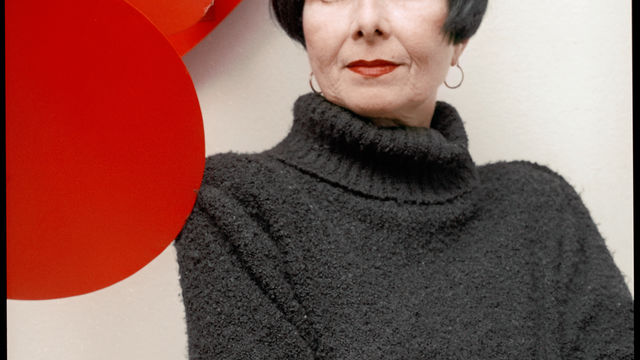
Lygia Pape
Born in 1927 in Nova Friburgo, Lygia Pape lived and worked in Brazil until her death in Rio de Janeiro in 2004. Pape studied philosophy at the Universidade Federal do Rio de Janeiro (UFRJ) before beginning her art studies in the 1950s with Fagya Ostrower (1920–2001) at the Museu de Arte Moderna do Rio de Janeiro, where she developed an early affinity for woodblock prints, which she later referred to as tecelares (weavings). Pape was influenced by European constructivism and began her art practice by exploring geometric abstraction. Color and light became important principles of her early and ongoing art investigations.
While at the Museu de Arte Moderna she met Hélio Oiticica (1937–1980), Ivan Serpa (1923–1973), and Aluíso Carvão (1920–2001), with whom she formed Grupo Frente in 1952. The group embraced notions of concrete art, rejecting tenets of Brazilian modernism such as figuration, representation of nature, and nationalism. In 1959 members of Grupo Frente, including Pape, Oiticica, and Lygia Clark (1920–1988), penned the neoconcrete manifesto, arguing for a geometric style that would allow some degree of expression and an art that provided viewers with a corporeal and phenomenological experience. While members worked mostly in painting and sculpture, Pape was the sole artist utilizing the woodblock print to express neoconcrete ideals; indeed she is thought to have been the only Brazilian printmaker working in geometric abstraction during the 1950s. In 1954 Pape exhibited a series of woodcuts in the first Grupo Frente exhibition, held at the Instituto Cultural Brasil-Estados Unidos in Rio de Janeiro.
Despite the possibility, Pape never printed in multiples. During the late 1950s and early 1960s she created a trilogy of artist's books, including Book of Creation (1959), that would become key works in the neoconcrete movement. Many of her works that followed required group participation to form a collective and shared creative experience. In the late 1950s she began exploring performance and video art and developed with the poet Reynaldo Jardim (1926–2011) Neoconcrete Ballets, in which dancers inhabited colored cylindrical costumes as they moved about the stage. In the 1960s Pape worked with the film group Cinema Novo as a designer of credits, posters, and displays. After the military coup d'état of 1964 she devoted most of her efforts to film, for which she introduced new social and political nuances. She continued to make experimental films into the 1970s. By 1978 and into the 2000s Pape developed large environments and site-specific works; some communicated important social themes while others reiterated her interest in light and active participation.
From 1969 to 1971 she taught at the Museu de Arte Moderna, and from 1972 to 1985 she taught semiotics at the Universidade Santa Úrsula, both in Rio de Janeiro. In 1980 she received a master's degree in philosophy of art from UFRJ, and in 1982 she was appointed professor of fine arts at UFRJ. Pape participated in major exhibitions both in Brazil and internationally, such as the São Paulo Bienal (1953, 1955, 1957, 1959, 1989) and the Salão Nacional de Arte Moderna in Rio de Janeiro between 1952 and 1960. She participated in the 50th Venice Biennale (2003) and the 12th Istanbul Biennale (2011).
—Courtney Smith
Selected Solo Exhibitions
1975–76 Eat Me: Gluttony or Lust?, Museu de Arte Moderna do Rio de Janeiro (traveled)
2000 Lygia Pape: Gávea de Tocaiai, Serralves, Lisbon
2001 Forma: Brazil, Geraldo de Barros and Lygia Pape, Americas Society, New York
2011–12 Lygia Pape: Magnetized Space, Museo Nacional Centro de Arte Reina Sofía, Madrid (traveled)
2017 Lygia Pape: A Multitude of Forms, Met Breuer, New York
Selected Bibliography
Bentes, Ivana, et al. Lygia Pape: Magnetized Space. Zurich: JRP|Ringier, 2015.
Carneiro, Lúcia, and Ileana Padilla. Lygia Pape. Rio de Janeiro: Nova Aguilar, 1998.
Cocchiarale, Fernando. Lygia Pape: Entre o olho e o espírito. Porto, Portugal: Mimesis, 2004.
Mattar, Denise. Lygia Pape: Intrinsecamente anarquista. Rio de Janeiro: Relume Dumará, 2003.
Pedrosa, Mario, Guy Brett, and Hélio Oiticica. Lygia Pape: Gávea de tocaia. São Paulo: Cosac & Naify, 2000.


